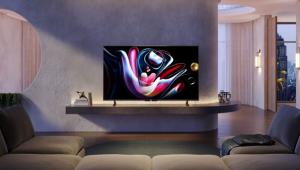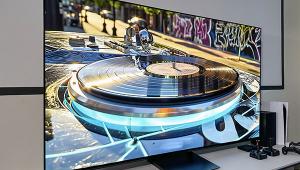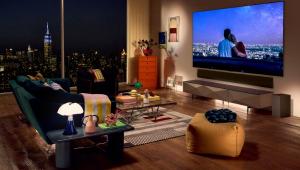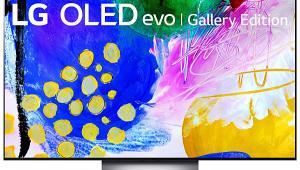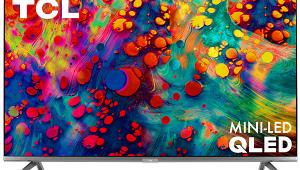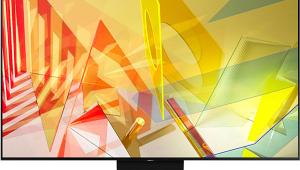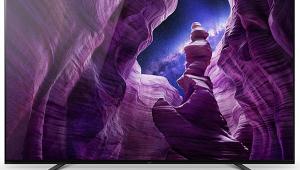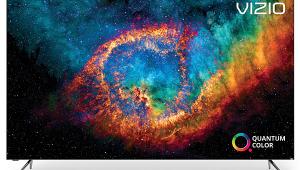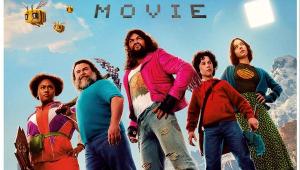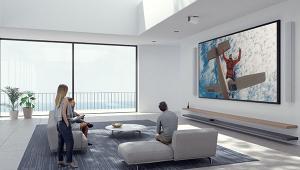Vizio M70Q7-J03 LCD Ultra HDTV Review Test Bench
For the control settings used here go to www.soundandvision.com/ The manual calibrations were made using Calman measurement software from Portrait Displays/Spectracal, together with X-Rite i1Pro3 Plus and Klein K-10A color meters and a Fresco Six-G test pattern generator from Murideo/AVPro.
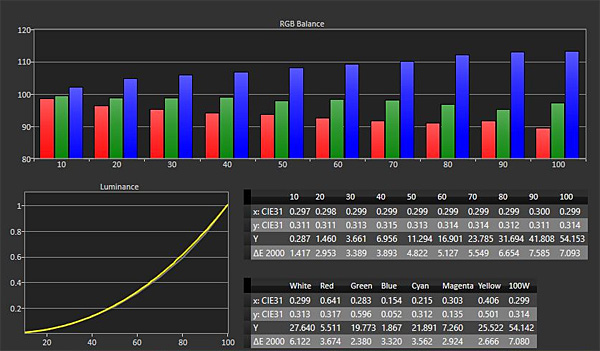
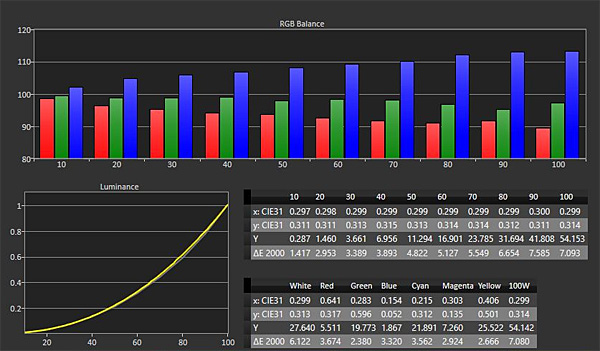
HD/SDR
Full-On/Full-Off Contrast Ratio: 104,118:1
Ten readings on a full black field produced results evenly distributed between and 0.001 and 0.000 foot-Lamberts (ft-L), for an average of 0.0005 ft-L (0.0017 nits). The peak white level of 51.6 (177 nits) used here resulted in the full-on/full-off contrast ratio shown above with Active Full Array local dimming set to Medium.
In the Warm Color Temperature setting, the pre-calibration grayscale Delta E (from 20% to 100%) was a maximum of 7.59 at 90% and a minimum of 3.1 at 20%. The error was primarily due to an excess of blue—an odd result for a Warm Color Temperature setting. Post-calibration, the maximum grayscale Delta E was 1.37 at 80% and the minimum 0.53 at 100%. The maximum color Delta E was 3.68 (cyan) before calibration and 3.46 (red) after calibration (no other post calibration color exceeded 2.68). The gamma followed the 2.4 gamma curve at a gamma setting of 2.4.
(Delta E is a figure of merit indicating how closely the set follows the ideal grayscale white point (D65) across the brightness range, or the accuracy of the primary (red, green, blue) and secondary (cyan, magenta, yellow) colors. Values below 3—some experts allow for 4—are generally considered visually indistinguishable from ideal.)
Input lag measured at 1080p was 43ms in Calibrated mode and 9.7ms in Game mode.
UHD/HDR10
Full On/Full Off Contrast Ratio: 202,400:1
I ran the HDR calibration three times before arriving at a satisfactory visual result. The first run produced the closest fit to the HDR EOTF curve (gamma for HDR). But it also resulted in a peak white level of 293 nits in the Calibrated mode, a weak result for HDR, with visibly poor dark scenes. The set's Vivid mode achieved 700 nits (in its default settings), but I wasn't about to use that for evaluation.
I had set the HDR Tone Mapping control to 30 to get the results shown here (and used the same settings in my viewing tests as well). During a fact check, Vizio noted that a Tone Mapping setting of 50 would produce a more accurate adherence to the EOTF curve (the "gamma" for HDR). But the only way I could achieve a tighter (but still not perfect) fit to this curve was to reduce the Contrast control setting to 45 (which resulted in a peak 100% white reading on a 10% window of 400 nits). It took a Contrast setting of 40 to achieve the best fit, but as noted above this produced a peak white level of around 300 nits. This was still quite watchable, but I suspect most viewers will want the 500 nits peak provided by the default Contrast control setting of 50.
With Tone Mapping set to 30 (there's no dedicated Backlight control in HDR), Brightness at 53, Contrast at 50 (producing some clipping on test patterns but rarely so on real source material), Active Full Array at High, and Gamma at 2.1-Normal, the peak white level was 506 nits (though it never exceeded 400 nits below 90%), and the black level 0.0025 nits, for the Full On/Full Off contrast ratio shown above. (With HDR, most of the image is in the bottom 50% of the brightness range, with the top 50% reserved for highlights.) Using the above settings, the peak white level measured 132 nits at 50%. Judged by that brightness figure instead of 100%, I can be concluded that the Full On/Full Off contrast ratio is actually 132/0.0025, or 52,800:1 (excluding the bright HDR highlights).
In the Warm Color Temperature setting the minimum post calibration grayscale Delta E was 2.17 at 20% and the maximum 10.4 at 80%. These deviations, produced by luminance errors in the EOTF curve, are common in HDR, but higher than usual here due to the compromises discussed above to achieve a better subjective result.
The final color Delta Es remained below 3.5 apart from cyan (5.9) and yellow (4.5). On a color checker test (measuring dozens of real-world colors) the average/peak Delta Es were 6.78/9.28 with luminance errors and 1.89/4.37 without luminance.
Brightness relative to white window size was 375 nits at 1%, 480 nits at 10%, 360 nits at 50%, and 325 nits at 100%. Saturation sweeps (measuring errors at levels from 20% to 100%) were fair for BT.2020 and P3 in BT.2020, and better (good) for Rec.709 in BT.2020. Using the 1976 standard, the Vizio achieved 81.8% of BT.2020 color and 94.2% of P3.
The Vizio passed all our standard video tests, though a Contrast setting of 47 offered more pre-white-clipping margin on a clipping test pattern in SDR. But the default setting of 50 looked fine for the real-world program material I viewed.—TJN


